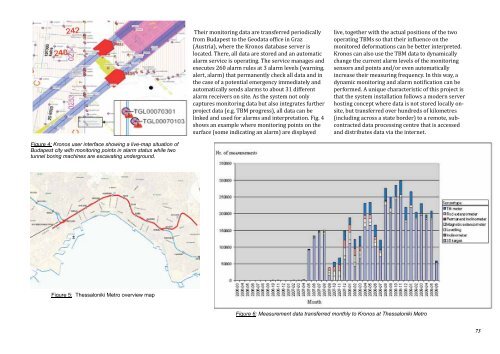Geoinformation for Disaster and Risk Management - ISPRS
Geoinformation for Disaster and Risk Management - ISPRS
Geoinformation for Disaster and Risk Management - ISPRS
Create successful ePaper yourself
Turn your PDF publications into a flip-book with our unique Google optimized e-Paper software.
Figure 4: Kronos user interface showing a live-map situation of<br />
Budapest city with monitoring points in alarm status while two<br />
tunnel boring machines are excavating underground.<br />
Figure 5: Thessaloniki Metro overview map<br />
Their monitoring data are transferred periodically<br />
from Budapest to the Geodata office in Graz<br />
(Austria), where the Kronos database server is<br />
located. There, all data are stored <strong>and</strong> an automatic<br />
alarm service is operating. The service manages <strong>and</strong><br />
executes 260 alarm rules at 3 alarm levels (warning,<br />
alert, alarm) that permanently check all data <strong>and</strong> in<br />
the case of a potential emergency immediately <strong>and</strong><br />
automatically sends alarms to about 31 different<br />
alarm receivers on site. As the system not only<br />
captures monitoring data but also integrates further<br />
project data (e.g. TBM progress), all data can be<br />
linked <strong>and</strong> used <strong>for</strong> alarms <strong>and</strong> interpretation. Fig. 4<br />
shows an example where monitoring points on the<br />
surface (some indicating an alarm) are displayed<br />
live, together with the actual positions of the two<br />
operating TBMs so that their influence on the<br />
monitored de<strong>for</strong>mations can be better interpreted.<br />
Kronos can also use the TBM data to dynamically<br />
change the current alarm levels of the monitoring<br />
sensors <strong>and</strong> points <strong>and</strong>/or even automatically<br />
increase their measuring frequency. In this way, a<br />
dynamic monitoring <strong>and</strong> alarm notification can be<br />
per<strong>for</strong>med. A unique characteristic of this project is<br />
that the system installation follows a modern server<br />
hosting concept where data is not stored locally onsite,<br />
but transferred over hundreds of kilometres<br />
(including across a state border) to a remote, subcontracted<br />
data processing centre that is accessed<br />
<strong>and</strong> distributes data via the internet.<br />
Figure 6: Measurement data transferred monthly to Kronos at Thessaloniki Metro<br />
73

















